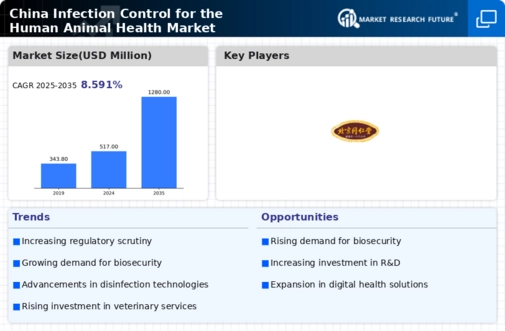Market Growth Projections
The Global China Infection Control for the Human Animal Health Market Industry is poised for substantial growth, with projections indicating a market size of 12.5 USD Billion in 2024 and a potential increase to 25 USD Billion by 2035. This growth trajectory suggests a compound annual growth rate (CAGR) of 6.5% from 2025 to 2035. Various factors contribute to this optimistic outlook, including rising consumer awareness, advancements in technology, and supportive government policies. The market's expansion reflects a broader recognition of the importance of infection control in safeguarding both animal and human health, indicating a robust future for the industry.
Government Regulations and Policies
The Global China Infection Control for the Human Animal Health Market Industry is significantly influenced by stringent government regulations and policies aimed at enhancing public health. The Chinese government has established comprehensive frameworks to monitor and control infectious diseases in animals, which directly impacts the market. These regulations often require veterinary practices to adopt advanced infection control protocols, thereby increasing the demand for related products and services. As these policies evolve, they are expected to create a favorable environment for market growth, with projections suggesting a market size of 25 USD Billion by 2035. This regulatory landscape is crucial for ensuring the safety and efficacy of animal health interventions.
Growing Awareness of Zoonotic Diseases
The growing awareness of zoonotic diseases significantly impacts the Global China Infection Control for the Human Animal Health Market Industry. As the public becomes increasingly informed about the transmission of diseases from animals to humans, there is a heightened demand for effective infection control measures. This awareness drives both consumer behavior and government initiatives aimed at preventing outbreaks. Consequently, the market is projected to reach 12.5 USD Billion in 2024, reflecting the urgent need for comprehensive strategies to manage zoonotic risks. Educational campaigns and public health initiatives are likely to further bolster this trend, emphasizing the interconnectedness of human and animal health.
Rising Demand for Animal Health Products
The Global China Infection Control for the Human Animal Health Market Industry experiences a notable increase in demand for animal health products. This surge is driven by the growing awareness of zoonotic diseases and the need for effective infection control measures. In 2024, the market is projected to reach 12.5 USD Billion, reflecting a heightened focus on safeguarding both animal and human health. The Chinese government has implemented various initiatives to enhance animal health standards, which further stimulates market growth. As the population becomes more health-conscious, the demand for vaccines and therapeutics is likely to rise, indicating a robust trajectory for the industry.
Technological Advancements in Diagnostics
Technological advancements in diagnostics play a pivotal role in the Global China Infection Control for the Human Animal Health Market Industry. Innovations such as rapid testing kits and advanced imaging techniques enhance the ability to detect infections in animals promptly. These advancements not only improve the accuracy of diagnoses but also facilitate timely interventions, thereby reducing the spread of infectious diseases. As the market evolves, the integration of artificial intelligence and machine learning into diagnostic tools is likely to further enhance efficiency. This trend aligns with the projected CAGR of 6.5% for 2025 to 2035, indicating a sustained growth trajectory driven by technological innovation.
Increased Investment in Research and Development
Investment in research and development is a critical driver for the Global China Infection Control for the Human Animal Health Market Industry. The focus on developing novel vaccines and therapeutics to combat infectious diseases in animals has intensified, supported by both public and private sector funding. This investment is essential for addressing emerging health threats and improving overall animal welfare. As a result, the market is expected to witness substantial growth, with projections indicating a potential market size of 25 USD Billion by 2035. The emphasis on R&D not only fosters innovation but also enhances the competitive landscape, ultimately benefiting the industry as a whole.


